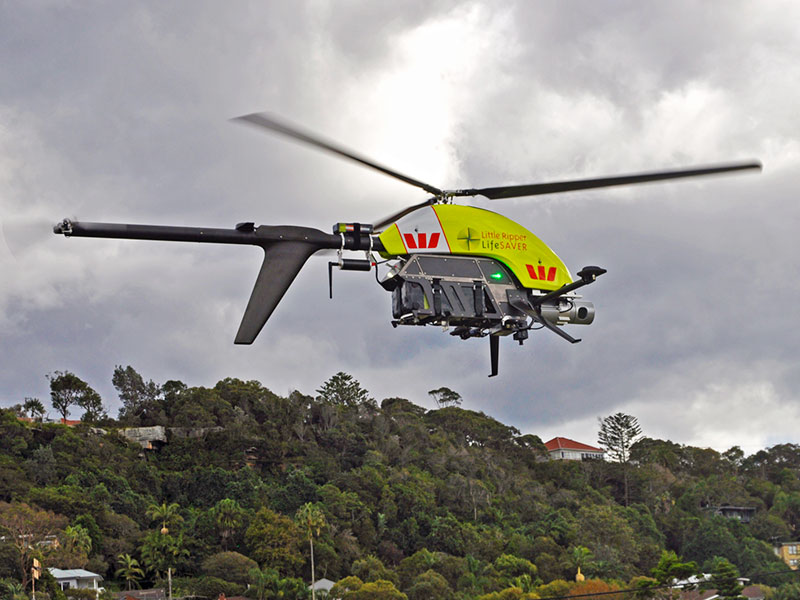Westpac Little Ripper drones to patrol beaches in Queensland


Westpac Little Ripper Life Saver Vapor 55 unmanned helicopter
Drones will back up Queensland lifeguards for the first time this summer as they work to save swimmers at some of the state's busiest beaches.
The Westpac Little Ripper Life Saver will be deployed on the Sunshine Coast and at North Stradbroke Island from the end of September as part of a trial with Surf Life Saving Queensland.
Another two will be based at Surfers Paradise and Cairns from the end of November.
The bank-backed initiative operates a suite of single and multi rotor unmanned aerial vehicles (UAVs), capable of long range deployment for fast search and rescue operations
The Ripper Group's Ben Trollope said the drones, which can detect sharks and release a floating device into the water below, would not change the role of lifesavers but provide them with another tool to help save lives.
Trollope expects the UAVs will primarily be used during emergencies, as they come equipped with speakers, cameras, and an inflatable rescue device that could be lowered into the water.
"The You Little Beauty is a three-metre inflation device that will keep four grown men afloat for 24 hours without manual inflation," Trollope told AAP. "It's not so much changing lifesaving, more so giving lifesavers another tool."
The drones have been trialled on beaches in New South Wales and Trollope said the plan is to equip each of Australia's 365 surf lifesaving clubs with the technology.
Westpac announced its sponsorship of the trial of the autonomous UAVs for search and rescue in February last year, building on the bank's sponsorship of the Westpac Life Saver Rescue Helicopter Services.
In the state's north, Townsville MP Scott Stewart said in November he wanted the Queensland Police Force to look into the use of drone technology in an effort to curb what he called a crime crisis.
"What I've been trying to do is look at as many different solutions as possible, and cutting-edge drone technology is so much cheaper than a police helicopter," Stewart said at the time. "We need to use the technology now and in the future to fight crime, not costly and old technology like helicopters."
Earlier that month, the state government amended legislation to allow farmers to use drones to spray their crops.
The changes to the Act, and the regulations that underpin it, are expected to give Queensland farmers access to the most "innovative aerial spraying technology" available.
The legislation also requires that UAV spraying operations are only performed by pilots who are authorised by the Civil Aviation Safety Authority (CASA) and hold qualifications that demonstrate a suitable level of chemical application competency.
The Queensland government announced a AU$1 million investment in remotely piloted aircraft (RPA) technology in July 2016, expected to benefit the LNG, agriculture, mining, energy, telecommunications, search and rescue, and environmental management industries.
In addition to the cash injection, the state government partnered with aerospace giant The Boeing Company, in conjunction with Boeing subsidiary Insitu Pacific, Shell's QGC project, and Telstra, to further the drone research.
"The project aims to capitalise on the capabilities inherent in drones to carry out remote-monitoring and inspection of key infrastructure and data analysis to allow for better decision-making," Queensland Premier Annastacia Palaszczuk said at the time.
As of September last year, commercial operators of "very small remotely piloted aircraft" were no longer required to obtain a number of regulatory approvals to fly their unmanned vehicles under new regulations approved by the Australian government.
The changes apply to drones used in commercial operations weighing less than 2 kilograms maximum take-off weight. Under the new rules, drone operators need to notify CASA that they intend to fly their aircraft, and adhere to a set of standard operating conditions including flying only during the day within a visual line of sight, below 120 metres; keeping more than 30 metres away from other people; flying more than 5.5 kilometres from controlled aerodromes; and not operating near emergency situations.
Facing the Senate Rural and Regional Affairs and Transport References Committee on Tuesday, CEO and Director of Aviation Safety at CASA Shane Carmody was instructed to look into geographic boundary technology to determine if creating a GPS-based "bubble" around a consumer drone was an effective method of keeping the devices out of harmful situations or no-fly zones.
With AAP